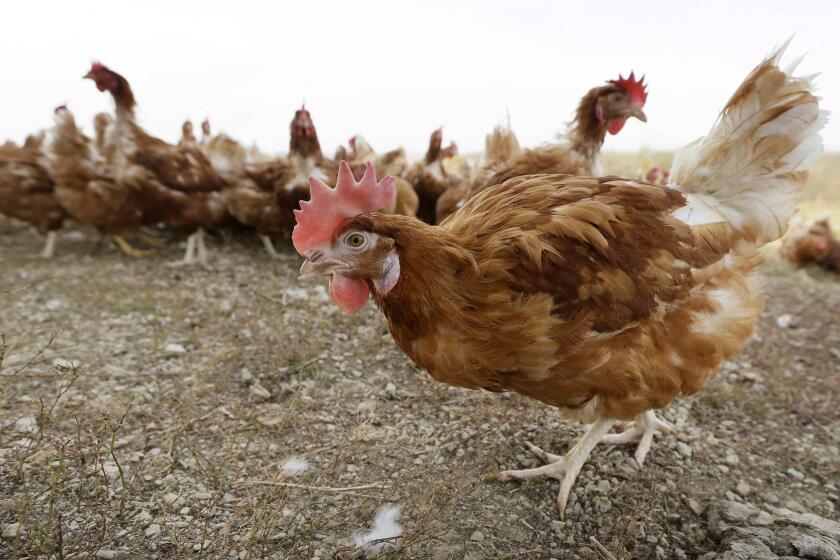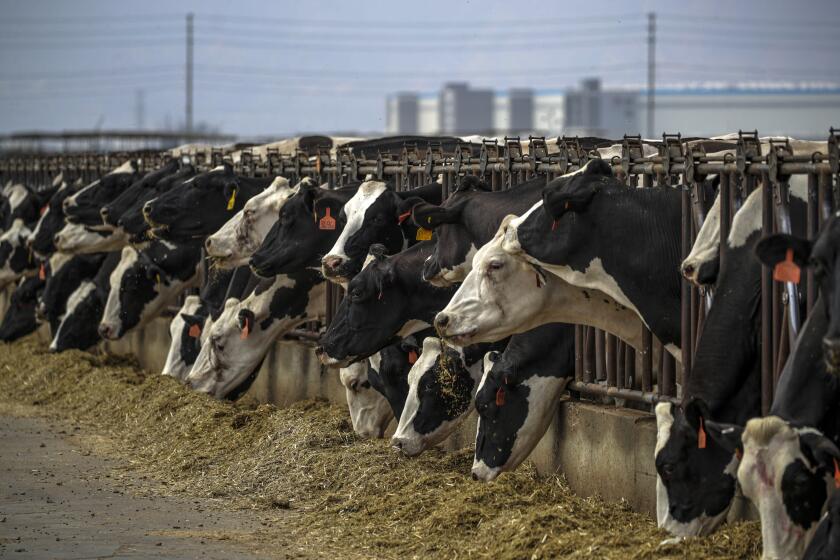
- Share via
- A child in Alameda County has tested positive for the bird flu.
- Health authorities say the source of the virus is unknown.
- No one else in child’s family has tested positive.
California health officials reported Tuesday that a child in Alameda County tested positive for H5N1 bird flu last week.
The source of infection is not known — although health officials are looking into possible contact with wild birds — and the child is recovering at home with mild upper respiratory symptoms.
The child was treated with antiviral medication, and the U.S. Centers for Disease Control and Prevention confirmed the findings Friday.
The initial test showed low levels of the virus and, according to the state health agency, testing four days later showed no virus.
“The more cases we find that have no known exposure make it difficult to prevent additional” infections, said Jennifer Nuzzo, professor of epidemiology and director of the Brown University School of Public Health’s Pandemic Center. “It worries me greatly that this virus is popping up in more and more places and that we keep being surprised by infections in people whom we wouldn’t think would be at high risk of being exposed to the virus.”
Cases of H5N1 bird flu in U.S. dairy and poultry workers have largely been mild. But a new case in a British Columbia teenager has experts worried.
A statement from the California Department of Public Health said that none of the child’s family members have the virus, although they, too, had mild respiratory symptoms. They are also being treated with antiviral medication.
Erica Pan, California’s state epidemiologist, said that the child and their family also tested positive for several other respiratory viruses — some of which are currently circulating throughout the state.
She would not name the other viruses.
Richard Webby, director of the World Health Organization’s Collaborating Center for Studies on the Ecology of Influenza in Animals and Birds and a researcher in the department of Infectious Diseases at St. Jude’s Children’s Research Hospital in Memphis, Tenn., said he knew nothing about the particulars of the case — other than what he had read in the news release — but, “I’m just hand waving here,” it is possible the low levels of H5 virus detected were just fragments of the virus picked up in the environment and not necessarily circulating in the child.
For instance, while pasteurized milk is safe to drink, there is inactivated virus in it — which could hypothetically trigger certain tests to appear positive.
Asked if this was a possibility, Pan said it was something she was considering — but stressed that the CDC still needs to confirm the test and it’s likely no one will ever be able to determine the source with certainty.
“Even with some of these farmworkers, if you have virus in the environment that maybe is inactivated, could you contaminate and have it in your nose? For example, a child who’s picking their nose... could it just be sitting there and not actually causing an infection?” she said.
She also said while the state considers it a high likelihood the virus is H5N1, there are other H5 viruses circulating — including an H5N5 virus that’s been detected in wild birds in eastern Canada. Pan said she was not aware of which other H5 viruses might be circulating in birds.
Pan said irrespective of the source or strain, the risk to the public remains low. Whatever the situation with the child may be, there is no evidence the virus moved from person to person.
She said that as wild birds migrate and shed virus into the environment, “we may see cases like this, with enhanced surveillance, become more common. As we do more testing, we might find more.”
The state’s news release noted that the child had attended a day care while symptomatic. People the child may have had contact with have been notified and are being offered preventative antiviral medication and testing.
“It’s natural for people to be concerned, and we want to reinforce for parents, caregivers and families that based on the information and data we have, we don’t think the child was infectious — and no human-to-human spread of bird flu has been documented in any country for more than 15 years,” said CDPH Director and State Public Health Officer Dr. Tomás Aragón.
The case comes days after the state health agency announced the discovery of six new bird flu cases, all in dairy workers. The total number of confirmed human cases in California is 27. This new case will bring it to 28, if confirmed. This is the first human case in California that is not associated with the dairy industry.
State officials say two dairy workers in the Central Valley have contracted H5N1 bird flu. They say the risk of infection remains low for the general population.
The total number of confirmed human cases in the U.S., including the Alameda County child, now stands at 54. Thirty-one are associated with the dairy industry, 21 with the poultry industry, and now two with unknown sources.
Pan said the state is actively investigating the case and is looking at wild birds as a potential source. She would not provide further detail except to say that near where the child lives, “there have been reports of a lot of birds around there.”
Genetic sequencing of the Canadian teenager’s virus shows mutations that may make it more efficient at moving between people. It is unclear if those changes happened in the virus before the teenager contracted it, or while it circulated in the teen. The Canadian virus is also a variant of H5N1 that has been associated with migrating wild birds, not cattle.
Genetic sequencing of the California child’s virus has not been released, so it is unclear if it is of wild bird origin, or the one moving through the state’s dairy herds.
In addition, WastewaterScan — an infectious disease monitoring network led by researchers from Stanford University and Emory University, with laboratory support from Verily, Alphabet Inc.’s life sciences organization — follows 28 wastewater sites in California. All but six have shown detectable amounts of H5 in the last couple of weeks.
There are no monitoring sites in Alameda County, but positive hits have been found in several Bay Area wastewater districts, including San Francisco, Redwood City, Sunnyvale, San Jose and Napa.
“This just makes the work of protecting people from this virus and preventing it from mutating to cause a pandemic that much harder,” said Nuzzo.









